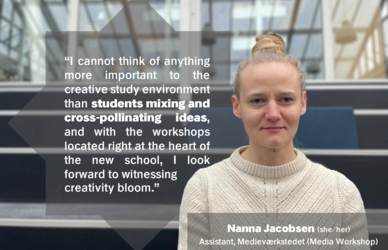Ready to REDO
At the REDO Conference in Kolding, the Cumulus Association decided to form a common front to address Global Goals for Sustainable Development. This means that in the coming years, 260 international educational institutions and more than 400,000 design students from around the world will be working on addressing some of the major challenges of the world, including water and climate issues.
The Danish Minister for Development Collaboration and the Cumulus Association have also signed a letter of intent to work together on the goals.
Speech from the future
Elsebeth Gerner Nielsen and Head of Research Anne Louise Bang closed the REDO Conference with a speech from the future. The speech they imagine the school management will give at the school's 75th anniversary. Because what was the actual outcome of the conference? Where will design be in 25 years? The conference may close today but it’s NOW that we start DOing. It’s now that we begin working on achieving impact. All conference participants (more than 300 designers, teachers, researchers, and others) leave Kolding with a personal action plan and a bigger network. And the Cumulus Association as an organisation has a plan prepared as well – a declaration for the Sommet Mondial du Design / World Design Summit - Montréal 2017 and a goal to work on the Global Goals for Sustainable Development.
Thank you all for a fantastic, eventful, inspiring and warm experience.
Read the speech from the future:
This is the year 2042. We want to thank all of you for being here, celebrating Design School Kolding’s 75th anniversary. Some of you were also here back in 2017 when we celebrated our 50th anniversary with an international conference under the framework of the Cumulus Association. The conference theme was REDO, and the goal was to explore how design, art, and media could achieve an even greater impact on the world. So how did it go? What have the Cumulus institutions achieved over the last 25 years? Let us sum up a few of the impact highlights.
- In 2017 the Cumulus members decided to address the UN Sustainable Goals, among others in collaboration with the @Danish Foreign Ministry. Part of the goal was to show how the UN Goals could become a lever for increased welfare, more jobs and consequently more hope in the world. One year, for instance, the Cumulus members addressed the issue of food waste. In the old days, 20 to 30 per cent of food went to waste, primarily because it was not stored correctly. Together with users, not least from the developing countries, the Cumulus members inspired the private sector and civil society to design recyclable plastic and metal storage systems. One of the solutions was inspired by the Danish deposit system and resulted in the fact that today, there is a deposit on all food packaging creating the incentive and money for recirculating and reusing the packaging. This has generated millions of jobs and allowed many more people to go to sleep on a full stomach.
- Secondly, the curriculum of the Cumulus institutions and their approach to education has also been revolutionized within the last 25 years. We are now fully capable of linking the deep knowledge of the disciplines with generic competencies broadening our possibilities for contributing to the society. Design has become part of the curriculum for a wide range of educations – resulting in the fact that engineers, economists and others have learned to speak our language. All in all, we have achieved an entirely new dialogue between the humanities and science.
- Yet, our greatest achievement is by far the fact that Cumulus’s collaboration with a number of other global players in design, art and media made us able to convince the world’s largest design companies – including Google, Facebook and Apple – to donate a small part of their profit to a global design fund. The very fund that has financed a vast part of global design research but also ensured the establishment of new design, art and media educational programmes around the world. Thanks to this voluntary tax payment, our programmes and research prosper like never before. Today the Cumulus Association has 1000 members. In 2017 we had 250.
And so we have mentioned just three highlights from the last 25 years. Still, all of them are excellent examples of how far we have come in proving that design, art and media can create a better and also far more just world.




